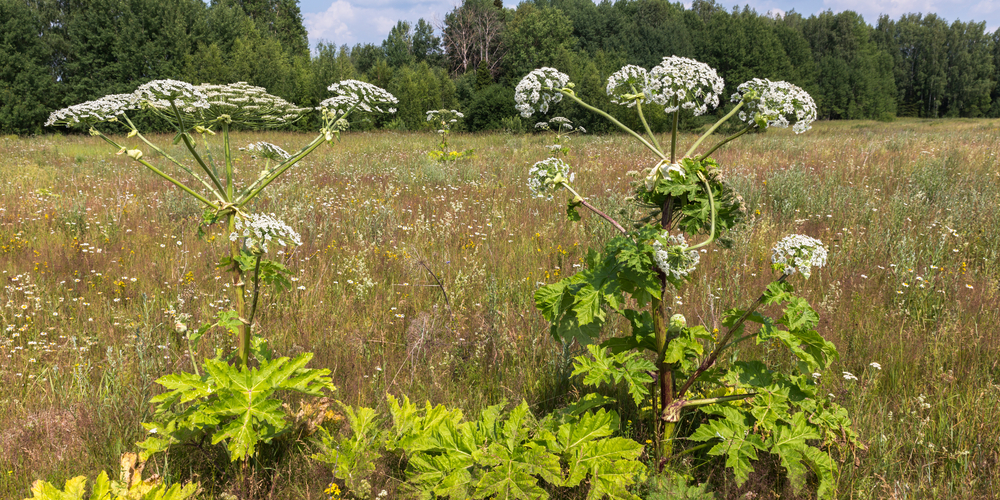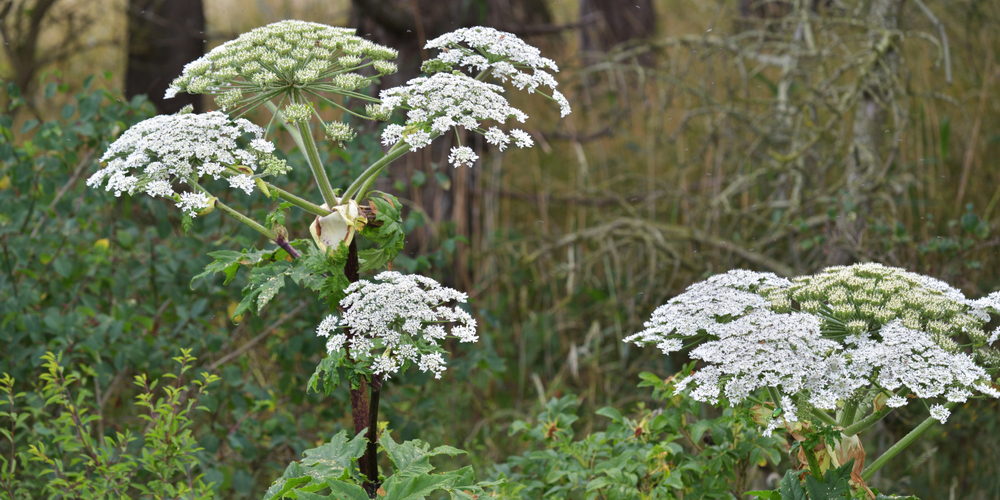Cow parsnip and giant hogweed are similar-looking plants that are best never encountered. However, if you do, it’s good to be able to tell the difference so that you can know what reactions you can expect. Let’s compare Cow Parsnip vs Giant Hogweed.
Let’s look at species information related to cow parsnip and giant hogweed and then compare their similarities and differences to help you better identify them.
Cow Parsnip

Cow parsnip (Heracleum maximum) is a native North American plant.
Cow parsnips are white with lacey flower clusters that are easy to mistake for Queen Anne’s lace or its lookalikes like giant hogweed, poison hemlock, spotted water hemlock, wild parsnip, and yarrow while it’s smaller. The flower cluster eventually will grow as big as a foot across.
When it’s reached its full height, cow parsnip can still look similar to taller plants like giant hogweed, angelica, wild parsnip, poison hemlock, common elderberry, and pokeberry.
Cow parsnips have coarse, hairy leaves that divide into three deeply-lobed leaflets. The leaflets are more rounded with deeper lobes than hogweeds.
Cow parsnips also have fuzzy, grooved stems. Another distinguishing feature is that it can grow 4-10 feet tall, which contrasts quite a bit with smaller lookalike plants.
Cow parsnips are dangerous to touch. Its sap is phototoxic, so it reacts with ultraviolet light to cause itchy rashes that range from mild irritation to severe blistering. The rashes can take weeks or months to heal and often leave behind scars.
If a cow parsnip plant touches your skin, your best defense is to thoroughly wash the area with soap and water and protect it from sunlight for the next 48 hours.
Giant Hogweed
Giant hogweed (Heracleum mategazzianum) is an invasive plant introduced to North America from Asia.
It has white, lacey flower clusters that are easy to mistake for Queen Anne’s lace until it grows taller. Ultimately, it will reach a gigantic 6-18 feet in height with umbrella-shaped flower clusters up to 2.5 feet across. Its deeply-lobed leaves grow up to five feet long.
Even when it’s reached its full height, giant hogweed can still look similar to its taller lookalikes like cow parsnip, angelica, wild parsnip, poison hemlock, common elderberry, and pokeberry.
It has fuzzy hairs at the nodes and bases of its petioles, which make it look similar to cow parsnip to the untrained eye. However, you can also identify it from its hollow, thick, ridged stems with purple spots.
Giant hogweed is not a gentle giant at all. If you want to remove this nuisance plant from an area, it’s important to note that it’s dangerous to touch. Handling the plant can result in painful, blistering rashes and permanent scarring. And if you rub your eyes with plant residue on your hands, you may even go blind permanently.
Cow Parsnip vs Giant Hogweed Similarities
The essential similiarities between these two plantas are as follows.
- They both have white, lacy flower clusters.
- They can both be mistaken for Queen Anne’s lace.
- They both have fuzzy hair on their stems.
- They both can cause painful symptoms if touched.
- They both grow tremendously tall.
- Both have ridged stems.
Cow Parsnip vs Giant Hogweed Differences
The differences between giant hogweed and cow parsnip are the following.
- Cow parsnip is a native North American plant, while giant hogweed is an invasive plant from Asia.
- Cow parsnip grows 4-10 feet tall, while giant hogweed can reach 6-18 feet tall.
- Cow parsnip is an endangered species or species of concern in some states.
- Touching giant hogweed can result in permanent skin damage or blindness, while cow parsnip does not.
- Of the two, only giant hogweed has purple spots on its stems.
- Cow parsnip leaves are more rounded and deeply lobed than giant hogweed leaves.
Final Thoughts on Cow Parsnip vs Giant Hogweed
Neither cow parsnip nor giant hogweed is a plant you want to touch. If you see a tall plant with lacey flower clusters, it’s best to stay away to avoid potential painful skin rashes or even blindness.
Proper identification is essential before touching anything that looks remotely like either of these plants. And even after it’s identified, removal is best left to a professional.
